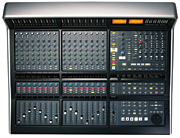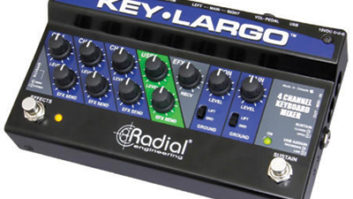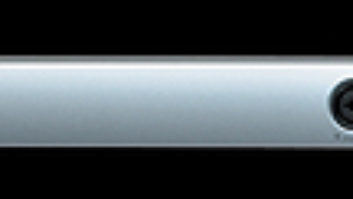
Matrix is a small-footprint analog mixer that offers up to 40 line inputs and uses the same SuperAnalogue technology as Solid State Logic’s Duality. Intended to be the nexus of any studio, Matrix simultaneously communicates and controls up to four different DAWs. Its compact size and ergonomic layout make it ideal for the project studio, ADR/Foley suites, jingle production studios or as the centerpiece of a sound-designer’s rig.
Matrix Revealed
Matrix was intentionally designed with no analog processors. Given the console’s $25,995 price point, this makes sense, considering the fact that many users prefer their favorite outboard mic preamps, EQs and compressors, and the fact that more and more engineers are turning to “in-the-box” DAW processing. Matrix, instead, offers a large, programmable virtual patchbay — a “matrix” from which to select and route your analog outboard gear for insertion into the Mix and Record buses and any of the 16 channels’ signal paths. And Matrix’s Total Recall (TR) system can store/recall console setups.
Conceptually, think of Matrix as two integrated products that operate as a single efficacious and powerful system with two concurrently running modes: Analog Focus and DAW Focus.
In Analog Focus, Matrix is an analog mixer with 16 dual line input channel strips, each with 100mm motorized faders. Typically, one line input would come from a recording chain’s output (mic pre/EQ/compressor) while the other is for the DAW’s track return. Channel controls include input level control, polarity flip and insert in/out switches, along with standard console controls for the cue/effects sends, solo and cut, and separate stereo recording bus selectors, plus a level control for the direct out.
In DAW Focus mode, all analog controls and settings remain intact except the physical faders, and solo and cut controls, which are “hijacked” for re-use in controlling the selected DAW. This mode adds more control with assignable V-Pots and Sel (select) keys, providing deeper access to any channel’s settings. DAW applications run on any number of attendant computers networked over regular Ethernet connections and Cat-5 cables. For MIDI communications, the Matrix uses ipMIDI (www.nerds.de).
Hooking Up
Matrix provides XLRs for AES/EBU monitor in and stereo bus output and optical ports for S/PDIF digital I/O. A supplied RJ-45 Ethernet crossover cable connects Matrix to your DAW. You’ll also need to connect a USB cable from Matrix to your computer and, if you own an SSL X-Logic X-Rack, connect its DB9 cable to the Matrix. Besides the headphone out, ⅛-inch mini jack for hooking up your iPod and XLR outs for small control room speakers, all analog connections are via 17 8-channel DB25 ports on the rear panel.
The Center Section
The top of the center section has analog master controls for the mix, recording and stereo cue buses. Each bus has a ±24dB gain trim pot, insert in/out, TR indicators (like most pots and switches on this board) and the Σ (sigma) symbol switch for mixing the pre-insert signal with the inserted processor’s output. The recording bus and stereo cue have “To Mix” buttons that act as analog, stereo subgroups by routing their signals to the stereo mix bus/master level control.
Four effects send submasters and four effects returns can feed the recording, mix and stereo cue buses. The default solo mode is destructive Solo-In-Place, but there are AFL (after-fader listen) buttons for the stereo cue, effects sends and returns.
Monitor and Cue Controls
Familiar to any SSL user is the Control Room Monitor section with volume level and Cut button, Dim button and level control, Mini speaker level, a Solo Clear button and a vertical column of source switches for monitoring: mix and recording buses, two external sources and the console’s DAC output.
Onboard 24-bit AD/DA converters operate at up to 176.4 kHz. There are no BNC clock jacks, but the converters will clock to any incoming digital source; otherwise, they default to 44.1 kHz.
Artist’s Monitoring is a cue system that will monitor the mix bus, the monitor mix, stereo cue, and external digital or analog sources. The “Σ” feature is used again to hear any of these sources summed together, such as for learning a guitar or vocal part from a connected iPod while on mic or recording and listen to a cue mix — cool! A simple HF/LF equalizer can contour the headphone mix for any kind of headphone or ear bud.
SuperCue provides latency-free monitoring during recording. During vocal overdubs, when Auto-Mon is selected and a DAW track is armed for record/playback, the stereo cue is sourced from the DAW track and the line input receiving the output of the vocal recording chain. You’ll hear yourself and the DAW track at the same time. Effects sends are sourced from the stereo cue so that on punch-in, Auto-Mon mutes the track’s DAW playback, allowing you to hear only yourself while retaining all effects.
S-Cue, Auto-Mon and send-source selection are all controlled on the Master Channel section, which also affects individual or global switching across the 16 channels. The channel input source, the way the channel audio is monitored, channel output source, and sources for the stereo cue and effects sends are all switched here. In DAW Focus mode, this section’s motorized, analog stereo mix bus fader also doubles as the master fader in DAWs that support it.
DAW Communication
Matrix DAW communication profiles include HUI (Human User Interface) for Pro Tools; MCU (Mackie Control Universal) for Logic 8 Pro, another MCU profile for Nuendo/Cubase and a MIDI CC (Continuous Controller) profile for controlling MIDI devices.
To expedite and integrate the DAW into the Matrix, SSL offers the cross-platform Matrix Remote software. Running on the DAW computer or any other computer on the network, the app determines Matrix’s operating “personality” by configuring the networked DAW’s HUI, MCU and CC functionality. Matrix Remote includes preprogrammed “starter” profiles for each of these protocols. Layers are toggled using the Layer keys, and personalized Profiles are edited, saved and selected using the Matrix Remote software. All configurations are saved locally and transmitted to the console for storage on a rear panel SD memory card. Matrix Remote data can also be saved along with the DAW files for recall on other Matrix consoles.
Programmable Soft Keys
Matrix’s Soft Keys and Utility buttons keep the attention off the computer and on the music production by putting the most common keystrokes and modifiers right on the desk. Soft Keys can be programmed to send HUI and MCU commands, plus any combination of QWERTY keystrokes. More than 360 functions can be assigned to Soft Keys for each of the five Soft-Key sets; four user-defined collections retain the preferences for multiple Matrix users.
Also standard are Utility buttons that cover a variety of functions — such as cycling through DAW tracks or accessing modifier computer keys — and 10 Pro Tools-specific transport buttons for accessing markers, looping and more. The large buttons for rewind/FF/stop/play/record and a large jog wheel for scrubbing DAW tracks reside within easy reach.
Mixing on the Matrix
To start a 32-channel mix on the Matrix, begin by assigning the DAW channels you’d like in front of you on the motor faders, and which you’d like on the stereo cue mixer now sourced from the second 16 line inputs. I put all vocals, signature guitar tracks, solos and drum elements on the faders as I wanted to process them further using an attached SSL X-Logic X-Rack. The X-Logic’s settings are also captured and stored along with the Matrix’s TR data.
The stereo cue faders are at unity when fully CW. I used these for DAW effects returns and instrument tracks that require little or no gain riding, such as tambourines, shakers and “one-time-only” events that I could set and forget. That left the four analog stereo effects returns for a Lexicon 480L. I could switch effects send sources as needed to post-fader or post-stereo cue. As I could only access two of the four sends at a time, I set up the 480L with two mono sends, one for each stereo machine.
The V-Pots can be easily assigned to automate the Pro Tools’ effects send faders. The Plug-In mode allows Pro Tools plug-in parameters to be spread out over only four V-Pots with the scribble strip showing the parameters and settings. In DAWs with MCU profiles (like Logic), all 16 V-Pots and scribble strip are available — much better than setting a plug-in’s compressor threshold with a mouse. Parameter values and resolution are identical to those seen on the Pro Tools GUI.
To set up most of my automation moves, the DAW Focus mode let me quickly bank across all of the faders in Pro Tools, making a tweak here and there. The scribble strip automatically updates with the Pro Tools track names as you bank around, so keeping names short is a good idea. The collection of default Pro Tools Soft Keys and the Transport were very helpful, necessitating less input from the computer keyboard.
Automating Matrix’s 16 channel faders is possible by adding MIDI faders in Pro Tools and assigning them to control the Matrix’s. I just banked to the MIDI faders in Pro Tools and made tweaks to my mix while hearing my inserted analog processing.
Programming insert chains was super-easy. I liked being able to try different combinations of the same processors quickly. For example, I saved a chain comprising an SSL EQ followed by the SSL Dynamics module, and another chain using the same processors but in reversed order. I wish I had about six full X-Logic X-Racks.
Matrix Reality
Matrix overflows with more capabilities and features than I can fit in this space. It is an infinitely malleable controller surface for any DAW and an excellent-sounding analog mixer/summing system — all attributes that take square aim at the current (and future) workflow needs of the modern music producer.
Barry Rudolph is an L.A.-based recording engineer/mixer. Visitwww.barryrudolph.com.
PRODUCT SUMMARY
COMPANY: SOLID STATE LOGIC
WEB: www.solid-state-logic.com
PRODUCT: Matrix
PRICE: $25,995
Pros: Control of up to four DAWs; cross-platform Matrix Remote software for easy DAW-to-Matrix configuration; SSL Total Recall saves console settings.
Cons: Processing and mic preamps are not included; rear panel SD memory card location is inconvenient; only four V-Pots available for Pro Tools plug-in parameters.



